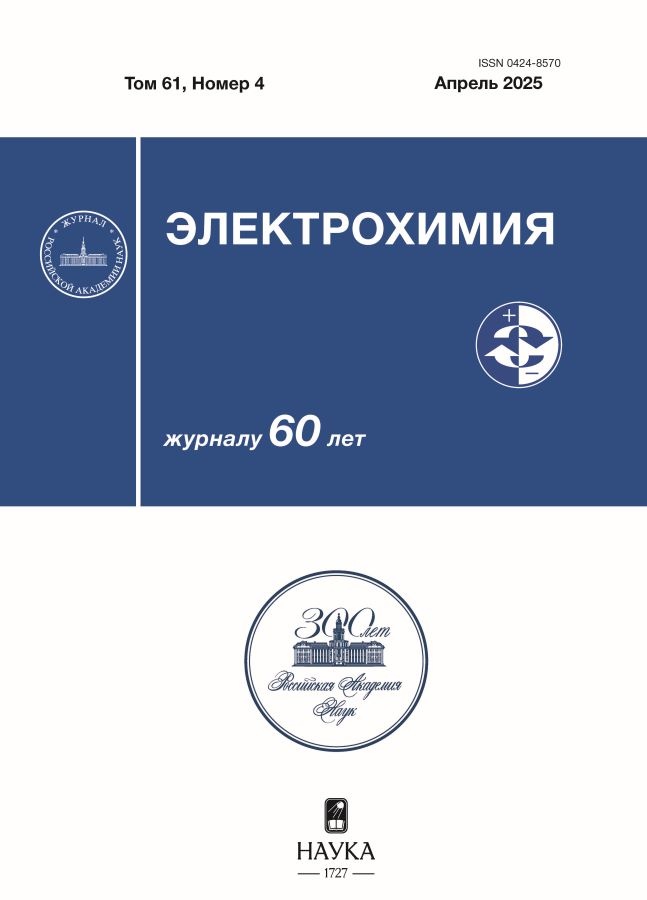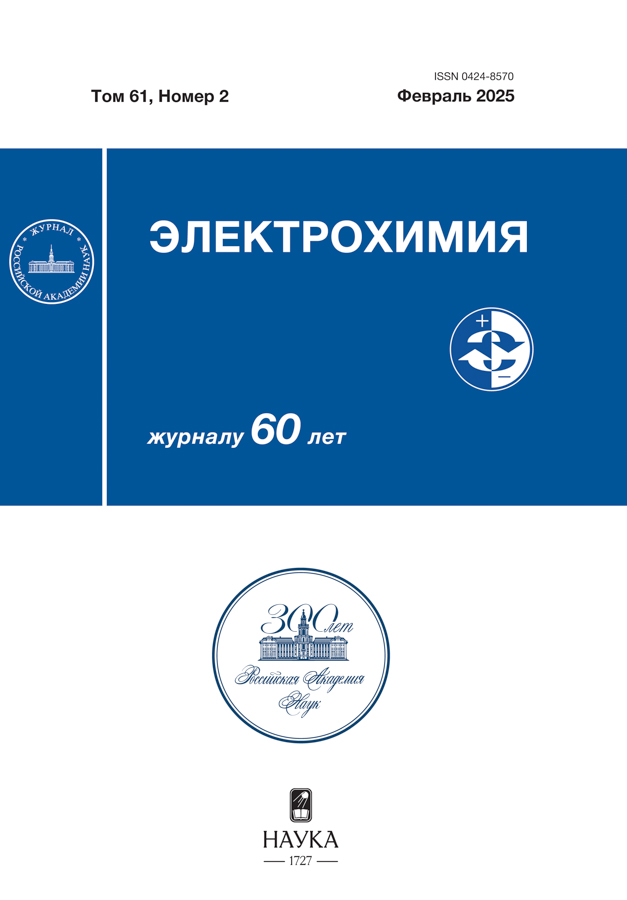The Role of Iodine and Pyridine Bases in the Electrocatalytic Oxidation of Alcohols Mediated by 4-AcNH-TEMPO
- Authors: Shubina E.N.1, Kashparova V.P.2, Ricker Y.A.1, Steglenko D.V.3, Zhukova I.Y.1,4
-
Affiliations:
- Don State Technical University
- Platov South Russian State Polytechnic University
- Southern Federal University
- Platov South-Russian State Polytechnic University
- Issue: Vol 61, No 2 (2025)
- Pages: 129-139
- Section: Articles by participants of the All-Russian Conference “Electrochemistry-2023” (Moscow, October 23–26, 2023)
- URL: https://www.clinpractice.ru/0424-8570/article/view/684443
- DOI: https://doi.org/10.31857/S0424857025020013
- EDN: https://elibrary.ru/DKOMNE
- ID: 684443
Cite item
Abstract
The role of iodine, pyridine bases and nitroxyl radical (NR) – 4-AcNH-TEMPO in the electro oxidative transformation of alcohols to carbonyl compounds in a two-phase environment CH2Cl2/NaHCO3 (aq.) has been studied. Using the CV method, it was established that the iodide ion in a weakly alkaline medium (pH 8.6) is oxidized to active forms of iodine (I2 and I+), which are terminal oxidizers for NR capable of being converted into oxoammonium cations (OС), necessary for the oxidation of alcohol. Spectrophotometrically it has been established that pyridine bases are capable of stabilizing I2 and/or I+ in the form of [PyI2], [PyI]+ complexes, the formation of which occurs predominantly in the organic phase. Stabilized forms of iodine effectively convert NR into OC at the interface. The formation of a catalytic complex between OС and a pyridine base occurs in the aqueous phase. CV studies have shown that the rate of NR-mediated alcohol oxidation increases up to 4 times in the presence of a pyridine base, in contrast to the oxidative transformation without a pyridine base. This proves the advantages of the NR/pyridine base catalytic system and the role of the pyridine base as a promoter in the inderect electrooxidation of alcohols.
Full Text
About the authors
E. N. Shubina
Don State Technical University
Email: kashparova2013@mail.ru
Russian Federation, Rostov-on-Don
V. P. Kashparova
Platov South Russian State Polytechnic University
Author for correspondence.
Email: kashparova2013@mail.ru
Russian Federation, Novocherkassk
Ya. A. Ricker
Don State Technical University
Email: kashparova2013@mail.ru
Russian Federation, Rostov-on-Don
D. V. Steglenko
Southern Federal University
Email: kashparova2013@mail.ru
Russian Federation, Rostov-on-Don
I. Yu. Zhukova
Don State Technical University; Platov South-Russian State Polytechnic University
Email: iyuzh@mail.ru
Russian Federation, Rostov-on-Don; Novocherkassk
References
- Каган, Е.Ш., Кашпарова, В.П., Жукова, И.Ю., Кашпаров, И.И. Окисление спиртов электрохимически генерируемым иодом в присутствии нитроксильных радикалов. Журн. прикл. химии. 2010. Т. 83. Вып. 4. С. 693. [Kagan, E.S., Kashparova, V.P., Zhukova, I. Yu., and Kashparov, I.I., Oxidation of alcohols by iodine in the presence of nitroxyl radicals generated electrochemically, Russ. J. Appl. Chem., 2010, vol. 83, no. 4, p. 745.] https://doi.org/10.1134/S1070427210040324
- Inokuchi, T., Liu, P., and Torii, S., Oxidations of Dihydroxyalkanoates to Vicinal Tricarbonyl Compounds with a 4-BzoTEMPO-Sodium Bromite System or by Indirect Electrolysis Using 4-BzoTEMPO and Bromide Ion, Chem. Lett., 1994, vol. 23, p. 1411. https://doi.org/10.1002/chin.199507075
- Miller, R.A. and Hoerrner, R.S., Iodine as a Chemoselective Reoxidant of TEMPO: Application to the Oxidation of Alcohols to Aldehydes and Ketones, Org. Lett., 2003, no. 5, p. 285. https://doi.org/10.1021/ol0272444
- Attoui, M. and Vatele, J.-M., TEMPO/NBu4Br-Catalyzed Selective Alcohol Oxidation with Periodic Acid, Synlett, 2014, vol. 25, p. 2923. https://doi.org/10.1055/s-0034-1378913
- Kashparova, V.P., Klushin, V.A., Zhukova, I.Yu., Kashparov, I.S., Chernysheva, D.V., Il’chibaeva, I.B., Smirnova, N.V., Kagan, E. Sh., and Chernyshev, V.M., A TEMPO-like nitroxide combined with an alkyl-substituted pyridine: An efficient catalytic system for the selective oxidation of alcohols with iodine, Tet. Lett., 2017, vol. 58, no. 36, p. 3517. https://doi.org/10.1016/J.TETLET.2017.07.088
- Kashparova, V.P., Klushin, V.A., Leontyeva, D.V., Smirnova, N.V., Chernyshev, V.M., and Ananikov, V.P., Selective Synthesis of 2,5-Diformylfuran by Sustainable 4-acetamido-TEMPO/Halogen-Mediated Electrooxidation of 5-Hydroxymethylfurfural, Chem. Asian J., 2016, vol. 11, no. 18, p. 2578. https://doi.org/org/10.1002/asia.201600801
- Shono, T., Matsumura, Y., Hayashi, J., and Mizoguchi, M., Electrochemical oxidation of alcohols using iodonium ion as an electron carrier, Tet. Lett., 1979, vol. 21, no. 2, p. 165. https://doi.org/10.1016/S0040–4039(01)85914–1
- Semmelhack, M.F., Chou, C.S., and Cortes, D.A., Nitroxyl-mediated electrooxidation of alcohols to aldehydes and ketones, J. Amer. Chem. Soc., 1983, vol. 105(13), p. 4492. https://doi.org/10.1021/ja00351a070
- Кашпарова, В.П. Шубина, Е.Н., Жукова, И.Ю., Ильчибаева, И.Б., Смирнова, Н.В., Каган, Е.Ш. Промотирующее действие пиридиновых оснований на непрямое электрохимическое окисление спиртов. Изв. вузов. Сер. Химия и химическая технология. 2019. Т. 62. № 9. С. 33. [Kashparova, V.P., Shubina, E.N., Zhukova, I. Yu., Ilchibaeva, I.B., Smirnova, N.V., and Kagan, E. Sh., Promoting effect of pyridine bases on indirect electrochemical oxidation of alcohols. Izv. Vyssh. Uchebn. Zaved. Khim. Khim. Tekhnol., 2019, vol. 62, no. 9, p. 33.] https://doi.org/10.6060/ivkkt.20196209.5923
- Bobbitt, J.M., Bartelson, A.L., Bailey, W.F., Hamlin, T.A., and Kelly, Ch.B., Oxoammonium Salt Oxidations of Alcohols in the Presence of Pyridine Bases, J. Org. Chem., 2014, vol. 79, no. 3, p. 1055. https://doi.org/org/10.1021/jo402519m
- Dryhurst, G. and Elving, Ph.J., Electrooxidation of halides at pyrolytic graphite electrode in aqueous and acetonitrile solutions, Anal. Chem., 1967, vol. 39, no. 6, p. 606. https://doi.org/10.1021/ac60250a014
- Verhoef, J.C., Electrochemical behaviour of iodide at a rotating platinum disk electrode in methanol, Electrochim. Acta, 1978, vol. 23, p. 433. https://doi.org/10.1016/0013-4686(78)87042
- Яралиев, Я.А. Электрохимия йода. Успехи химии. 1982. Вып. 6. С. 990. [Yaraliev, Y.A., Russ. Chem. Rev., 1982, vol. 51, no. 6, p. 566.] https://doi.org/org/10.1070/rc1982v051n06abeh002866
- Резникова, Л.А., Моргунова, Е.Е., Бограчев, Д.А., Григин, А.П., Давыдов, А.Д. Предельный ток в системе йод-йодид на вертикально расположенном электроде в условиях естественной конвекции. Электрохимия. 2001. Т. 37. С. 442. [Reznikova, L.A., Morgunova, E.E., Bograchev, D.A., Grigin, A.P., and Davydov, A.D., Limiting Current in Iodine–Iodide System on Vertical Electrode under Conditions of Natural Convection, Russ. J. Electrochem., 2001, vol. 37, p. 382.] https://doi.org/10.1023/a:1016626006594
- Sandford, C., Edwards, M.A., Klunder, K., Hickey, D.P., Li, M., Barman, K., Sigman, M.S., White, H.S., and Minteer, S., A Synthetic Chemist’s Guide to Electroanalytical Tools for Studying Reaction Mechanisms, Chem. Sci., 2019, vol. 10, p. 6404. https://doi.org/10.1039/c9sc01545k
- Будников, Г.К., Вяселев, М.Р., Майстренко, В.Н. Основы современного электрохимического анализа. М.: Мир, 2003. 592 с. [Budnikov, G.K., Vyaselev, M.R., and Maistrenko, V.N., Fundamentals of modern electrochemical analysis. (in Russian), Moscow: Mir, 2003. 592 p.]
- Hubbard, A.T., Osteryoung, R.A., and Anson, F.C., Further Study of the Iodide-Iodine Couple at Platinum Electrodes by Thin Layer Electrochemistry, Anal. Chem., 1966, vol. 38, no. 6, p. 692. https://doi.org/10.1021/ac60238a006
- Hanson, K.J. and Tobias, Ch.W., Electrochemistry of iodide in propylene carbonate i. cyclic voltammetry monitored by optical spectroscopy, J. Electrochem. Soc., 1987, p. 1.
- Gao, Y.F., Yu, L.L, Lu, Q-Q, and Ma, C.A., Electrochemical Oxidation Behavior of Iodide on Platinum Electrode in Acid Solution, Acta Phys. Chim. Sin., 2009, vol. 25, no. 7, p. 1421. https://doi.org/10.3866/PKU.WHXB20090735
- Kolthoff, I.M. and Jordan, J., Voltammetry iodine and iodide at rotate platinum electrodes, J. Amer. Chem. Soc., 1953, vol. 75, p. 1571. https://doi.org/10.1023/A:1016626006594
- Geissler, W., Nitzsche, R., and Landsberg, R., Über die elektrochemische oxydation von Jodid und Jod zum hypojodit an graphit elektroden, Electrochim. Acta, 1966, vol. 11, no. 4, p. 389. https://doi.org/10.1016/0013-4686(66)80017-8
- Miller, F.J. and Zittel, H.E., Voltammetry of the iodine system in aqueous medium at the pyrolytic graphite electrode, J. Electroanal. Chem., 1966, vol. 11, no. 2, p. 85. https://doi.org/10.1016/0022-0728(66)80067-0
- Шубина, Е.Н., Кашпарова, В.П., Букурова, В.С., Катария, Я.В., Жукова, И.Ю. Высокоэффективный однореакторный электрокаталитический метод трансформации спиртов в нитрилы. Журн. орган. химии. 2023. T. 93. № 10. С. 1563. [Shubina, E.N., Kashparova, V.P., Bukurova, V.S., Kataria, Ya.V., and Zhukova, I. Yu., Highly Efficient One Pot Electrocatalytic Method for Transforming Alcohols to Nitriles, Russ. J. Gen. Chem., 2023, vol. 93, no. 10, p. 2498.] https://doi.org/10.1134/S1070363223100031
- Tissot, H., Coustel, R., Rochet, F., Boucly, A., Carteret, C., André, E., Bournel, F., and Gallet, Jean-J., Deciphering Radiolytic Oxidation in Halide Aqueous Solutions: A Pathway Toward Improved Synchrotron NAP-XPS Analysis, Phys. Chem., 2023, vol. 127, no. 32, p. 15825. https://doi.org/10.1021/acs.jpcc.3c03676
- Batsanov, A.S., Lightfoot, A.P., Twiddle, S.J.R., and Whiting, A., Bis(2,6-dimethylpyridyl)iodonium dibromoiodate, Acta Crystallogr. Sect. E: Struct. Rep. Online, 2006, vol. 62, no. 3, p. o901. https://doi.org/10.1107/s1600536806003680
- Ward, J.S., Gomila, R.M., Frontera, A., and Rissanen, K., Iodine(I) complexes incorporating sterically bulky 2-substituted pyridines, RSC Adv., 2022, vol. 12, p. 8674. https://doi.org/10.1039/d2ra01390h
- Клюбин, В.В., Клюбина, К.А., Маковецкая, К.Н. Кинетика растворения кристаллического иода в этаноле при комнатной температуре и 60C. Журн. физ. химии. 2018. Т. 92. № 2. С. 277. [Klyubin, V.V., Klyubina, K.A., and Makovetskaya, K.N., Kinetics of Crystalline Iodine Dissolution in Ethanol at Room Temperature and at 60C, Russ. J. Phys. Chem., 2018, vol. 92, p. 295.] https://doi.org/10.1134/S0036024418020127
- Palmer, D.A., Ramette, R.W., and Mesmer, R.E., The hydrolysis of iodine: Equilibria at high temperatures, J. Nucl. Mater., 1985, vol. 130, p. 280. https://doi.org/org/10.1016/0022-3115(85)90317-4
- Crawford, E., McIndoe, J.S., and Tuck, D.G., The Energetics of the X2 + X– → X3 – Equilibrium (X = Cl, Br, I) in Aqueous and Nonaqueous Solution, Can. J. Chem., 2006, vol. 84, no. 12, p. 1607. https://doi.org/10.1139/v06-165
- Gardner, J.M., Abrahamsson, M., Farnum, B.H., and Meyer, G.J., Visible Light Generation of Iodine Atoms and I–I Bonds: Sensitized I–Oxidation and I3– Photodissociation, J. Amer. Chem. Soc., 2009, vol. 131, no. 44, p. 16206. https://doi.org/10.1021/ja905021c
- Bernal-Uruchurtux, M.I., Kerenskaya, G., and Janda, K.C., Structure, spectroscopy and dynamics of halogen molecules interacting with water, Int. Rev. Phys. Chem., 2009, vol. 28, no. 2, p. 223. https://doi.org/10.1080/01442350903017302
- Zingaro, R., Werf, C.A.V., and Kleinberg, J., Evidence for the Existence of Unipositive Iodine Ion in Solutions of Iodine in Pyridine, J. Amer. Chem. Soc., 1951, vol. 73, no. 1, p. 88. https://doi.org/10.1021/ja01145a031
- Chaudhuri, J. N. and Basu, S., Charge-transfer interaction between iodine and aza-aromatics, Trans. Farad. Soc., 1959, vol. 55, p. 898. https://doi.org/10.1039/tf9595500898
- Brayer, G.D. and James, M.N.G., A charge-transfer complex: bis(2,4,6-trimethyl-1-pyridyl)iodonium perchlorate, Acta Crystallogr., Sect. B: Struct. Sci, 1982, vol. 38, no. 2, p. 654. https://doi.org/10.1107/S0567740882003689
- Le, T.P.P. and Opaprakasit, P., Conversion Mechanisms of Nitroxyl Radical (TEMPO), Oxoammonium Cation, and Hydroxylamine in Aqueous Solutions: Two-Dimensional Correlation Ultraviolet–Visible Spectroscopy, Appl. Spectrosc., 2020, vol. p. 1. https://doi.org/10.1177/0003702820961097
- Кашпарова, В.П., Папина, Е.Н., Каган, Е.Ш., Жукова, И.Ю. Электрохимический вариант синтеза оксоаммониевой соли и нитроксильного радикала. Изв. вузов. Сев.-Кавк. регион. Техн. науки. 2018. № 3 (199). С. 129. [Kashparova, V.P., Zhukova, Yu., Papina, E.N., and Kagan, E. Sh., Electrochemical option of synthesis of oxoammonium salt and nitroxyl radical. Izv. vuzov. Sev.-Kavk. region. Technical sciences (in Russian), 2018, no. 3 (199). p. 129.] https://doi.org/10.17213/0321-2653-2018-3-129-133
- Nutting, J.E., Rafiee, M., and Stahl, Sh.S., Tetramethylpiperidine N-Oxyl (TEMPO), Phthalimide N-Oxyl (PINO), and Related N-Oxyl Species: Electrochemical Properties and Their Use in Electrocatalytic Reactions, Chem. Rev., 2017, vol. 118, p. 4834. https://doi.org/10.1021/acs.chemrev.7b00763
Supplementary files



















